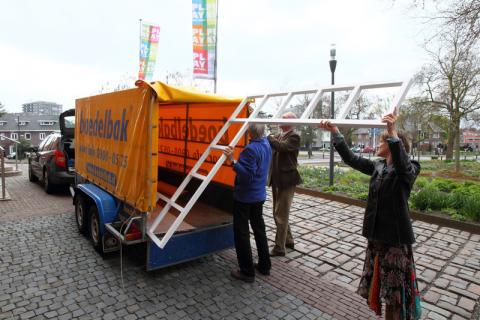Possessed

In the 1973 June edition of Flash Art Magazine, the artist Sol LeWitt was granted the opportunity to respond to an advertisement that was published in the same magazine two issues earlier, in which he was accused of copying the works of other artists and presenting them as his own “innovations”. Following the accusation were three illustrations of minimalist drawings and paper reliefs, each attributed doubly to either Sol LeWitt or Jan Schoonoven, François Morellet and Oskar Holwek.
Dismissing the formal similarities between the works as irrelevant, Sol Lewitt responded by saying “I believe that ideas, once expressed, become the common property of all. They are invalid if not used, they can only be given away and cannot be stolen. Ideas of art become the vocabulary of art and are used by other artists to form their own ideas (even if unconsciously).”
This quote now stands most appropriately over the entrance to the latest exhibition at the Van Abbe Museum in Eindhoven, “In-between Minimalisms”. The show is a typical roundup of usual suspects such as Carl Andre, Daniel Buren, Dan Flavin, Donald Judd, Sol LeWitt and Niele Toroni, displayed in a style that has become an icon of the modern art museum itself: the works inhabit their stark white rooms in such a way that the spectator feels like an intruder, wondering whether it is the art, or the space it occupies that is on display.
Thankfully though, the zen-like silence that usually accompanies these kind of exhibitions is shattered by a constant banging and grating emanating from the central gallery, where the Danish artists' collective SUPERFLEX have installed a metal workshop. Here is where, for the duration of the show, the museum's staff is diligently assembling reproductions of LeWitt's Untitled (Wall Structure). Every time one of these white, aluminum objects is finished, a visitor is randomly selected from the completed forms they have left behind in a letterbox in the corner of the gallery, and asked to take the object home, free of charge.
SUPERFLEX's FREE SOL LEWITT project appears to uphold LeWitt's proposition that the idea or concept is the most important aspect of the artwork, in the sense that “the idea becomes a machine that makes the art.” It is a maxim that can be applied to many of the other works in the exhibition, that are the product of concepts such as repetition, seriality or mechanical reproduction. Some of these works even exist only as instructions on paper, to be carried out by draftsmen on site. It also suggests that anyone who knows about a work of art can own it. The visitors that come to pick up their free copy, however, are asked to sign an agreement, acknowledging that FREE SOL LEWITT by SUPERFLEX is not an artwork by Sol LeWitt.
It is a tiny clause, but it lies at the heart of the contradictions SUPERFLEX's work exposes with regard to the legacy of early conceptual art. In the 60s, some hailed it as a revolutionary practice that sought to dematerialize art and free it from commodity status and market orientation. Yet by the 70s it was already being shown and sold for substantial sums in prestigious galleries worldwide. Is it possible, then, that the real legacy of conceptual art is not just that an idea can become art, but that it can become private property as well?
This seems irreconcilable with LeWitt's quote at the beginning of this text, but it is a fate that must have been hard to avoid, considering that the growth of the market for conceptual art coincided with that of advanced capitalism, which draws value from immaterial labour, the flow of information and intellectual property. Artists who saw their vision being substantiated by a fresh new demand for conceptual art, soon had to accommodate the special needs of that market when the works exchanged hands again later, at ever higher prices.
Art that exists as an idea had to be authenticated, just like any other work of art, if its investment value was to persist across subsequent transactions. And since an idea provides no space for signatures, artists and their dealers drew up all kinds of certificates and contracts to establish authorship of the work. While many of these contracts also strove to restrict the loss of control over an artwork after it changed owner, by asserting the artist's moral rights or granting him or her a percentage of any increase in value each time it was resold, their main purpose was still to provide the owners with proof of the artwork's provenance.
Turning a conceptual work of art into a product that falls under the regime of intellectual property rights, has a fundamental effect on its significance, because it allows the concept of monetary value to eclipse all other concepts. So when that work finds its way into the collections of our museums, as an artifact of our common cultural heritage, one may rightly question just what it is it represents, and what has been preserved of the discourse from which it came forth.
By releasing it from the shackles of copyright restrictions, SUPERFLEX's contract challenges the museum to reconsider what it means for a public institution to “possess” a work of art, and it invites us, the public, to claim what was already ours.
Published in:
- Mugalari, el suplemento cultural del periódico Gara.
Recent comments